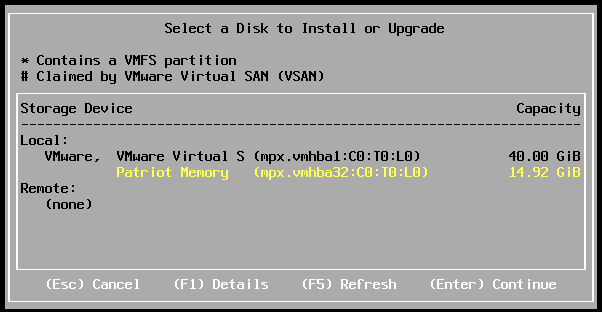

- HOW TO CREATE A BOOTABLE USB FOR VMWARE ESXI 6.7 HOW TO
- HOW TO CREATE A BOOTABLE USB FOR VMWARE ESXI 6.7 DRIVERS
- HOW TO CREATE A BOOTABLE USB FOR VMWARE ESXI 6.7 UPDATE
- HOW TO CREATE A BOOTABLE USB FOR VMWARE ESXI 6.7 UPGRADE
- HOW TO CREATE A BOOTABLE USB FOR VMWARE ESXI 6.7 WINDOWS 10
Click Ok and wait to finish.ĭepending on the ISO image and USB drive speed, this operation it might take some time. Note: If any of explained ESXi upgrade methods are not suitable for you, you can write the ESXi ISO installation image to a DVD disk or USB flash drive, boot from that medium, run the ESXi 7.0 installer, and select the disk where ESXi 6.7 is installed as the destination disk. Select type USB Drive and the destination drive. Select Diskimage ISO and then browse for your ISO image downloaded in step 2.
HOW TO CREATE A BOOTABLE USB FOR VMWARE ESXI 6.7 HOW TO
To do this follow the How to Format USB Flash Drive to FAT32 in Mac OS tutorial. If your USB drive is not FAT32 formatted you need to format it. Step3įrom security reasons MacOS will not allow to open directly the app, so right click on the. Step2ĭownload the ESXI v6.5 from VMware website. This tutorial can be applied to any operating system like Windows or Linux family OS.
HOW TO CREATE A BOOTABLE USB FOR VMWARE ESXI 6.7 DRIVERS
If not, perhaps a previous version of ESXi may be a better fit or supplemental drivers may be needed to be included before your specific server will boot properly.This tutorial will present how to create an ESXI vSphere v6.5 bootable USB drive using a Mac OS operating system. In addition, before the ISO is downloaded from VMware, it is highly recommended that you peruse VMware's Compatibility Guide on its website, which allows users to verify that their hardware is supported by VMware and for use with its products. Note: If the USB will not boot on your server, ensure that the USB boot functionality is enabled in the BIOS or UEFI listing. Once the process is complete, your USB-based VMware ESXi installation media will be created and ready to boot the hypervisor setup on your server. If this occurs, click Yes to automatically download the newest compatible version from the internet. However, there are times when physical devices must be connected to virtual machine guest operating systems.
HOW TO CREATE A BOOTABLE USB FOR VMWARE ESXI 6.7 UPDATE
During this process, you may be prompted to update the menu.c32 file, as the one used by the ISO image may be older than the one used by Rufus on the flash drive. In today’s virtualized world in the enterprise datacenter, often, we no longer think about physical devices. The transfer process will vary depending on the specifications of your workstation, but typically it should be completed within several minutes.

Please note that any data on the drive will be erased ( Figure D). Figure Cįinally, click on the Start button to begin the process of formatting and partitioning the UFD and extracting the contents of the ISO to your USB drive. Skip down to the CD icon and click on it to select the previously downloaded VMware ESXi ISO image ( Figure C). In the next section, Partition Scheme, select MBR Partition Scheme For BIOS Or UEFI from the dropdown menu ( Figure B).

Verify that under Device, the UFD is listed ( Figure A). Create multiple USB drive images from a single GUI instance (no need to repeat the. Start by inserting your UFD into the Windows computer and launching Rufus. BoMC does not refresh USB key information. SEE: VMware vSphere: The smart person's guide (TechRepublic) Creating the USB installer Internet access (optional, but recommended).Windows workstation (running XP or later).Note, this guide is based on macOS only, if you are using Windows please use the Rufus utility. I’ve included a short video demonstration. This is an updated guide using ESXi 7.0b. However, before jumping into this, there are a few requirements: Last year I posted a guide on creating a ESXi 6.7 USB Installer on macOS without any 3rd party tools. Read on and we'll cover the steps necessary to create a bootable UFD, with VMware ESXi on it, from your Windows workstation. And given their flexible read/write nature, even updating installers is a breeze using the very same UFD. While many newer servers have added modern touches to facilitate VMware deployments, such as internal SD card readers for loading the hypervisor onto the SD to maximize all available resources, these servers have also done away with legacy items, like optical drives-and that makes loading VMware onto the servers a bit difficult initially.īut fret not, as USB flash drives (UFDs) have proven to be more than capable at replacing optical media for booting operating systems. It even has a free offering-ESXi-which is its base hypervisor that can be run on any bare-metal supported server hardware to get IT pros familiar with the product and help organizations on their way to migrating their servers to virtual machines.

With regard to consolidating servers by virtualizing them, the industry standard is VMware, with its extensive software and support offerings for businesses of all sizes.
HOW TO CREATE A BOOTABLE USB FOR VMWARE ESXI 6.7 WINDOWS 10


 0 kommentar(er)
0 kommentar(er)
